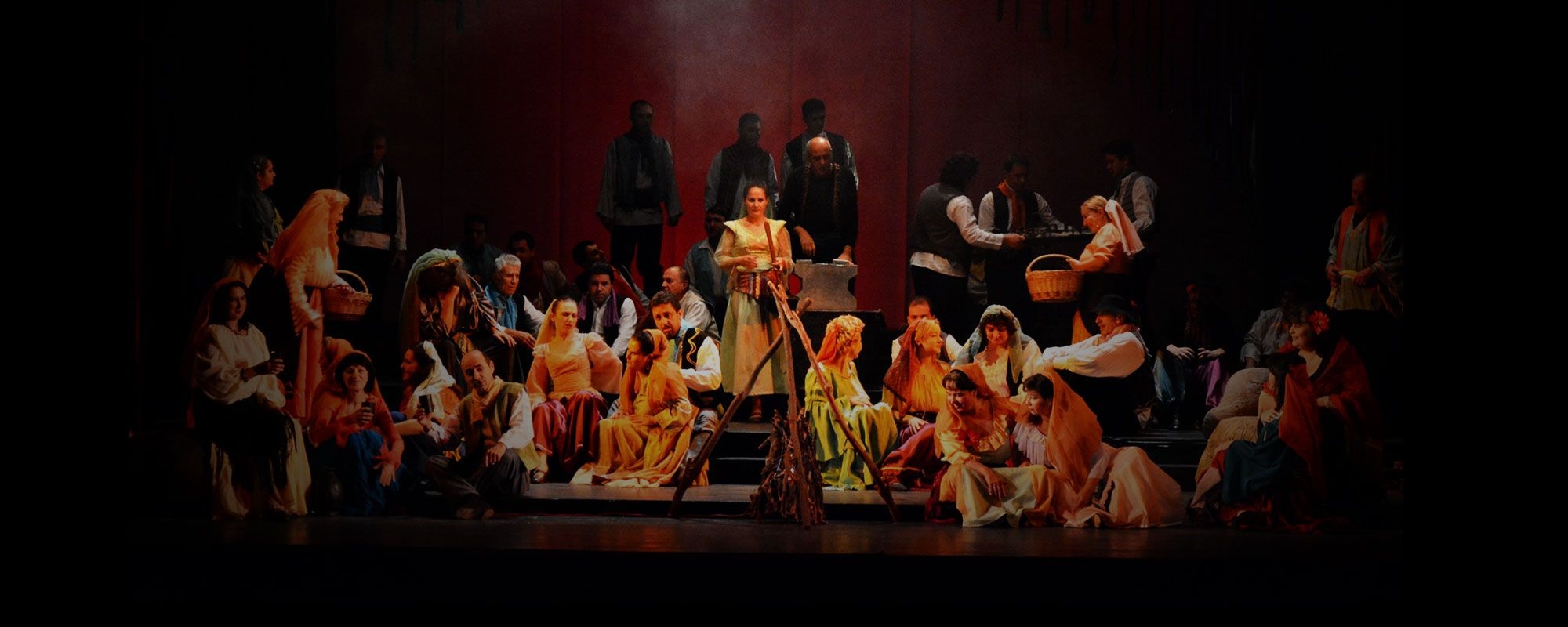The Troubadour
Giuseppe Verdi
- World premiere
- Teatro Apollo din Roma, 19 ianuarie 1853
- Romanian Opera Craiova Premiere
- 9 decembrie 2004
- Time Length
- aprox. 3h – două pauze
- Extra info
- Spectacol în limba italiană cu supratitrare în limba română
Opera in four acts composed by Giuseppe Verdi.
Libretto by Salvatore Cammarano, based on the tragedy El Trovator by Antonio Garcia Gutiérez.
The action takes place in the 15th century, in Biscay and Aragon.
ACT I
Ferrando, the captain of guards of the Count di Luna, tells his men how the gypsy Azucena, intent on avenging her mother’s death, who had been burnt alive as a witch, had abducted one of the children of her old master and had thrown it into fire.
In the garden of the palace, Leonora, the noble lady-in-waiting to the Princess of Aragon, talks to her confidante Ines of the love she feels for a mysterious troubadour. After the two women leave, the young Conte di Luna comes beneath Leonora’s window, attracted by a strong love for her. Suddenly, the voice of a troubadour is heard in the night (romanza). Answering the fervent call, Leonora comes down to the garden and, confused by the darkness, rushes to the arms of Count di Luna, with passionate words. Manrico, the mysterious troubadour, also appears. The two men defy one another and cross swords (trio). Unable to separate them, Leonora faints.
ACT II
Gathered in their camp, the gypsies are working (choir). Lost in thoughts, the old gypsy Azucena remembers the death of her mother who, while burning alive, had shouted: “Avenge me!”. Then, many years ago, overwhelmed by the grief, Azucena had abducted one of the sons of Count di Luna, to throw it to the burning fire. She suddenly realizes, horrified, that, unknowingly, in her anger, she had thrown her own baby to the fire (aria). Manrico understands nothing of the words of the woman he thought was his mother. “Then, who am I?” asks the young man. Azucena regains consciousness, but she avoids answering his question. The gypsy scolds Manrico for the noble gesture of having spared the young Count di Luna on the night of the duel in the garden.
A messenger arrives with two important news: the Castellor fortress has fallen into the hands of Urgel’s partisans and Manrico is called to organise the defence against the royalists who are preparing to attack. At the same time, Manrico finds out that Leonora, thinking her lover had been killed in the duel, had decided to enter a convent. The young man leaves in a hurry.
At the convent where Leonora is about to take the veil, Count di Luna arrives with a group of soldiers, determined to abduct the woman he loves. Leonora bids farewell to Ines. The brutal intervention of soldiers is prevented by the arrival of Manrico and the partisans. Leonora rushes to the arms of the man she had thought dead.
ACT III
The Castellor fortress, where Manrico and Leonora have taken refuge, is assaulted by the troops of Count di Luna. Azucena is caught close to the soldiers’ camp. Ferrando recognizes her as the woman who, years ago, had thrown the brother of the young count to the fire. Azucena confesses to being Manrico’s mother. Blind with jealousy and thirsty for revenge, the count condemns her to be burned.
Inside the fortress, Leonora and Manrico live some moments of happiness. A messenger announces that Azucena has been captured by enemy troops. With no hesitation, Manrico goes to battle to save his mother (aria).
ACT IV
Manrico and the partisans have been defeated. Mother and son now share the same cell. Leonora desperately searches a way to save her beloved (aria). In love, Count di Luna asks for the young woman’s love and faithfulness in exchange for Manrico’s life. Accepting the proposal, Leonora sips the poison hidden under the stone of the ring she wears on her finger (duet), then enters the prison to personally inform her beloved on his release. Thinking he was betrayed, Manrico rejects her, only to understand the truth as Leonora dies (trio). At the same time, di Luna orders Manrico’s execution and compels Azucena to see her son’s torture. However, the gypsy has fulfilled her revenge. She reveals to the count that Manrico actually was his brother.
*Grigore Constantinescu & Daniela Caraman-Fotea, Ghid de operă, Bucharest, 1971
**Ana Buga & Cristina Maria Sârbu, 4 secole de teatru muzical, Bucharest, 1999
***Ioana Ștefănescu, O istorie a muzicii universale, Vol. IV, Bucharest, 2002


